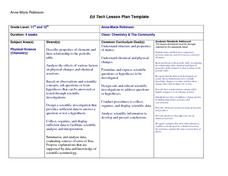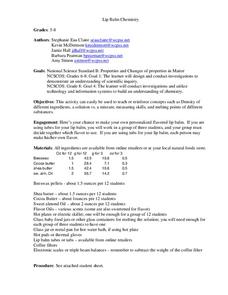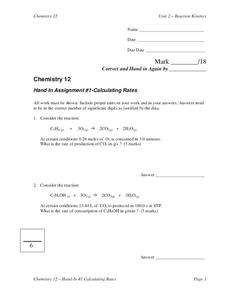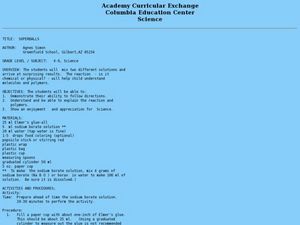Virginia Department of Education
Thermochemistry: Heat and Chemical Changes
What makes particles attract? Here, learners engage in multiple activities that fully describe colligative properties and allow the ability to critically assess the importance of these properties in daily life. Young chemists conduct...
Curated OER
Acid-Base Chemistry
In this acid-base worksheet, students write balanced chemical equations given the reactants for 18 reactions. If no reaction occurs, they write N.R. They also rank acids and bases in increasing order.
Curated OER
Chemical Reactions
In this reactions worksheet, students state the differences between a coefficient and subscript and an exothermic and endothermic reaction. Students review the different types of reactions. This worksheet has 13 short answer questions.
Curated OER
Chemistry & The Community
Students complete a Webquest which investigates the chemistry in items such as shampoo. They research the Internet, perform a lab experiment, and write a scientific lab report with their findings. Upon completion of the activities, the...
Curated OER
Types of Reactions (Demonstration)
Learners visually observe chemical changes that occur when various solutions are combined. Teacher explains chemical reactions that are happening.
Curated OER
Ziplock Chemistry
Pupils participate in an experiment in which the substances are sealed in a plastic bag. Watching the experiment, they determine why the chemical reaction is taking place and calculate the temperature change. To end the lesson, they...
Virginia Department of Education
Matter and Energy: Equations and Formulas
Using simple materials, an informative lesson demonstrates the Law of Conservation of Matter and explains how to balance chemical equations. Young chemists perform experiments, analyze reactions, and balance chemical equations on their...
Curated OER
Chemiluminescence
Students explore chemiluminescence through various experiments. In this chemistry instructional activity, students explain the chemical reaction that drives the process. They give real life applications of chemiluminescence.
Curated OER
Bridging the Gaps Between the Three Worlds of Chemistry
Students examine the observed world, molecular world, and the symbolic world of chemistry. They observe a demonstration of the conductivity of solutions, describe the properties of acids and bases, and predict the outcome of solution...
Curated OER
Lip Balm Chemistry
Students explore density, mixture and solutions in a reaction. In this chemistry lesson, students create their own chap-stick using ingredients they analyze for their chemical contents. They discuss measuring skills, melting points and...
Curated OER
Equilibrium Equations
In this equilibrium worksheet, students calculate the equilibrium constant for reactions and the equilibrium concentrations. This worksheet has 10 problems to solve.
Curated OER
Calculating Rates
In this rates worksheet, students determine the rate of production or consumption for given reactions. Students write chemical equations in complete ionic form or net-ionic form. This worksheet has 6 problems to solve.
Curated OER
Molarity, Excess and Percent Yield
In this molarity worksheet, students are given balanced equations and they are to calculate the mass or volume of reactants and products. Students calculate the theoretical, percentage, and actual yield for chemical equations. This...
Curated OER
Superballs
Students mix two different solutions to become more familiar with molecules and polymers. In this chemistry lesson, students decide whether or not the reaction between two solutions is chemical or physical. Students then observe the...
Curated OER
Chemical Changes to Matter
Students analyze the causes of corrosion. In this chemistry lesson, students investigate what is necessary to cause chemical changes in matter. Students discover the causes of rust and tooth decay.
Curated OER
Energy and Energy Conversion
Third graders investigate different energy conversions through hands-on activities. In this energy lesson, 3rd graders move through four stations and conduct experiments illustrating energy conversions. Wave energy, chemical energy,...
Curated OER
Ice Cream in a Bag
Here is a good version of this classic chemistry activity. Learners are given a simple recipe for how to make home-made ice cream by putting all of the ingredients into a ziploc bag. Before doing the activity, I would recommend having a...
Curated OER
Activity #20 Tear An Aluminum Can In Half
Students observe the chemical reaction between CuCl2 and aluminum. They identify the evidence for a chemical change. Pupils answer the following questions after observing the experiment: How do you know a chemical reaction occurred?,...
Curated OER
Chemical Reactions
Students work in groups to define chemistry vocabulary including the terms reactants, products, exothermic and endothermic. They then combine the group definitions to arrive at a consensus definition for the class. Students also listen...
Curated OER
Chemical Volcano
Students observe a demonstration performed by the teacher. They examine of a series of acid/base reactions and discover how various indicators work.
Beyond Benign
Sustainability Bingo
Play a little Bingo and learn a little chemistry. The third installment in a 24-part series gives scholars the opportunity to play a game of Bingo while they review the 12 principles of green chemistry. The principles make up the Bingo...
Beyond Benign
Writing the Principles
What is the difference between chemistry and green chemistry? The first lesson of the 24-part green chemistry series introduces scholars to its 12 principles. The tendency is toward nontoxic materials and sustainability.
Beyond Benign
12 Principle Match Up
Can you find a match? Scholars review the 12 principles of green chemistry by playing a matching game. The second lesson of the series reinforces the principles from the first lesson. Individuals play the matching game and also complete...
Curated OER
Activity #19 Oxygen For Yeast
Students observe and record what occurs when yeast is added to hydrogen peroxide. They indicate why a chemical reaction (decompostion) must have occurred during the experiement. Pupils explain why yeast was used. Students comprehend the...

























